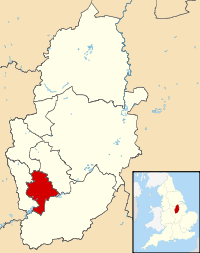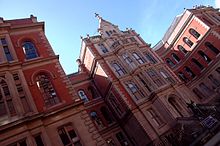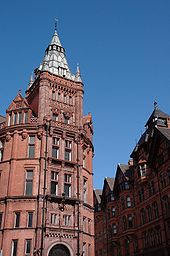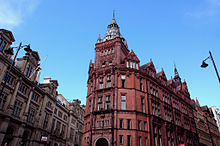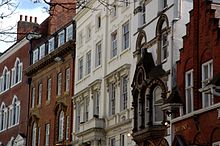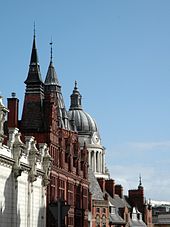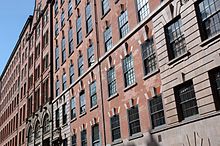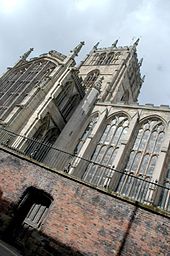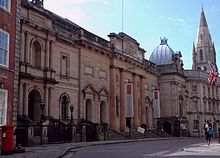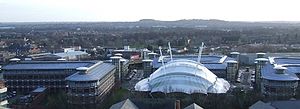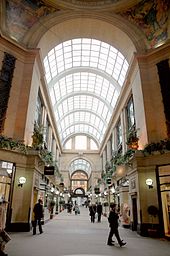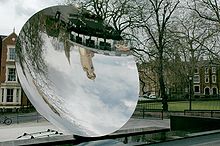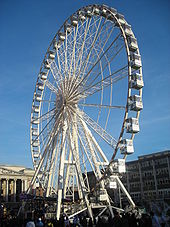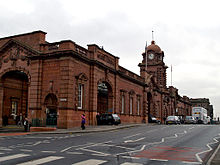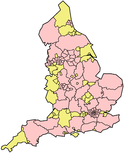- Nottingham
-
This article is about the City of Nottingham in England. For the county, see Nottinghamshire. For The University of Nottingham, see The University of Nottingham. For other uses, see Nottingham (disambiguation).
City of Nottingham — City & Unitary authority — Nottingham skyline, plus landmarks clockwise from top left: Robin Hood, Council House, NET Tram, (middle) Trent Bridge, the Castle Gate House, Wollaton Hall, Ye Olde Trip to Jerusalem and Nottingham Forest City Ground 
Coat of arms of Nottingham City CouncilNickname(s): Queen of the Midlands, The Lace City Motto: Vivit Post Funera Virtus (Virtue Outlives Death)[1] Nottingham shown within Nottinghamshire and England Coordinates: 52°57′N 1°08′W / 52.95°N 1.133°WCoordinates: 52°57′N 1°08′W / 52.95°N 1.133°W Sovereign state United Kingdom Constituent country England Region East Midlands Ceremonial county Nottinghamshire Admin HQ Nottingham Council House Settled 600 City Status 1897 Government - Type Unitary authority, City - Governing body Nottingham City Council - Council Leader Coun. Jon Collins (Lab) - Executive Labour - MPs Chris Leslie (Lab)
Graham Allen (Lab)
Lilian Greenwood (Lab)- Lord Mayor Coun. Michael Wildgust Area - City & Unitary authority 28.8 sq mi (74.61 km2) Elevation[2] 200 ft (61 m) Population (2010 est.) - City & Unitary authority 306,700 - Density 9,673.6/sq mi (3,735/km2) - Urban 666,358(LUZ:825,600) - Ethnicity
(2005 Estimate)[3]81.6% White (76.5% White British)
7.7% S. Asian
4.7% Black British
3.2% Mixed Race
2.8% Chinese and otherTime zone Greenwich Mean Time (UTC+0) - Summer (DST) British Summer Time (UTC+1) Postal Code NG Area code(s) 0115 Twin Cities -  — Ghent
— GhentBelgium (since 1985) -  — Harare
— HarareZimbabwe (since 1981) -  — Karlsruhe
— KarlsruheGermany (since 1969) -  — Ljubljana
— LjubljanaSlovenia (since 1963) -  — Minsk
— MinskBelarus (since 1966) -  — Ningbo
— NingboChina (since 2005) -  — Timişoara
— TimişoaraRomania (since 2008) Grid Ref. SK570400 ONS code 00FY ISO 3166-2 GB-NGM NUTS 3 UKF14 Website www.nottinghamcity.gov.uk/ Nottingham (
 i/ˈnɒtɪŋəm/ not-ing-əm) is a city and unitary authority in the East Midlands of England. It is located in the ceremonial county of Nottinghamshire and represents one of eight members of the English Core Cities Group. Whilst Nottingham has always had a tightly-drawn boundary (accounting for its relatively small population of 306,700), Nottingham's Urban Area has a population of approximately 805,800; according to the 2001 census, it is the seventh largest urban conurbation in the United Kingdom, ranking between those of Liverpool and Sheffield, and the largest in the East Midlands.[4][5] Eurostat's concept of the Larger Urban Zone listed the area's population at 825,600 as of 2004.
i/ˈnɒtɪŋəm/ not-ing-əm) is a city and unitary authority in the East Midlands of England. It is located in the ceremonial county of Nottinghamshire and represents one of eight members of the English Core Cities Group. Whilst Nottingham has always had a tightly-drawn boundary (accounting for its relatively small population of 306,700), Nottingham's Urban Area has a population of approximately 805,800; according to the 2001 census, it is the seventh largest urban conurbation in the United Kingdom, ranking between those of Liverpool and Sheffield, and the largest in the East Midlands.[4][5] Eurostat's concept of the Larger Urban Zone listed the area's population at 825,600 as of 2004.Nottingham is famed for its links with the legend of Robin Hood and, during the Industrial Revolution, obtained worldwide recognition for its lace-making and bicycle industries. It was granted its city charter as part of the Diamond Jubilee celebrations of Queen Victoria in 1897 and has since been officially titled the City of Nottingham.
Contents
History
See also: History of NottinghamIn Anglo-Saxon times, around 600 AD[citation needed] the site formed part of the Kingdom of Mercia and was known in the Brythonic language as Tigguo Cobauc, meaning Place of Caves. In Welsh it is known poetically as Y Ty Ogofog, "The Cavey Dwelling".[6] When it fell under the rule of a Saxon chieftain named Snot[7] it became known as "Snotingaham"; the homestead of Snot's people (Inga = the people of; Ham = homestead). Snot brought together his people in an area now known as the Lace Market.
Nottingham was captured in 867 by Danish Vikings[citation needed] and later became one of the Five Burghs – or fortified towns – of The Danelaw.
In the 11th century Nottingham Castle was constructed on a sandstone outcrop by the River Leen. The Anglo-Saxon settlement developed into the English Borough of Nottingham and housed a Town Hall and Law Courts. A settlement also developed around the castle on the hill opposite and was the French borough supporting the Normans in the castle. Eventually, the space between was built on as the town grew and the Old Market Square became the focus of Nottingham several centuries later. On the return of Richard Coeur de Lion from the Crusades, the castle stood out in Prince John's favour. So, it was besieged by Richard, and after a sharp conflict, captured.[8]
By the 15th century, Nottingham had established itself as the centre of a thriving export trade in religious sculpture made from alabaster[9] The town became a county corporate in 1449[10] giving it effective self-government, in the words of the charter, "for eternity". The Castle and Shire Hall were expressly excluded and technically remained as detached Parishes of Nottinghamshire.
The Adams Building in the Lace Market – a former lace warehouse
During the Industrial Revolution, much of Nottingham's prosperity was founded on the textile industry; in particular, Nottingham was an internationally important centre of lace manufacture. However, the rapid and poorly planned growth left Nottingham with the reputation of having the worst slums in the British Empire outside India.[citation needed] Residents of these slums rioted in 1831, in protest against the Duke of Newcastle's opposition to the Reform Act 1832, setting fire to his residence, Nottingham Castle.
In common with the UK textile industry as a whole, Nottingham's textile sector fell into headlong decline in the decades following World War II, as British manufacturers proved unable to compete on price or volume with the output of factories in the Far East and South Asia.[citation needed] Very little textile manufacture now takes place in Nottingham, but the city's heyday in this sector endowed it with some fine industrial buildings in the Lace Market district. Many of these have been restored and put to new uses.
Nottingham was one of the boroughs reformed by the Municipal Corporations Act 1835, and at that time consisted of the parishes of Nottingham St Mary, Nottingham St Nicholas and Nottingham St Peter. It was expanded in 1877 by adding the parishes of Basford, Brewhouse Yard, Bulwell, Radford, Sneinton, Standard Hill and parts of the parishes of West Bridgford, Carlton, Wilford (North Wilford). In 1889 Nottingham became a county borough under the Local Government Act 1888. City status was awarded as part of the Diamond Jubilee celebrations of Queen Victoria, being signified in a letter from the Prime Minister the Marquess of Salisbury to the Mayor, dated 18 June 1897. Nottingham was extended in 1933 by adding Bilborough and Wollaton, parts of the parishes of Bestwood Park and Colwick, and a recently developed part of the Beeston Urban District. A further boundary extension was granted in 1951 when Clifton and Wilford (south of the River Trent) were incorporated into the city.[11][12]
Demographic evolution of Nottingham
Year Population 4th century <37 10th century <1,000 11th century 1,500 14th century 3,000 Early 17th century 4,000 Year Population Late 17th century 5,000 1801 29,000 1811 34,000 1821 40,000 1831 51,000 Year Population 1841 53,000 1851 58,000 1861 76,000 1871 87,000 1881 159,000 Year Population 1901 240,000 1911 260,000 1921 269,000 1931 265,000 1951 306,000 Year Population 1961 312,000 1971 301,000 1981 278,000 1991 273,000 2001 275,000 Electric trams revolutionised public transport in Nottingham on their inception in 1901; they would serve the city for 35 years until the bus network was expanded in 1936. The city's road network was improved drastically between 1922 and 1932 when a new dual carriageway was built. Housing conditions also began to improve the city's poorer residents at this time, when the first council houses were built on new suburban estates to rehouse families from slum clearances. Mass private house building also took place, with the process continuing to boom until some 30 years after World War II ended in 1945.
Trams made their comeback in Nottingham after 68 years when a new tram network was opened in 2004.[13]
To the sporting world, Nottingham's biggest claim to fame was undoubtedly being home to the world's oldest professional club, Notts County, who were formed in 1862. However, Notts County's subsequent history has proven to be a relatively low profile one, and in 1975 a significant event occurred which would change the sporting image of Nottingham forever.
Brian Clough, who had managed nearby Derby County to Football League First Division title glory in 1972, was appointed manager of Nottingham Forest, then struggling in the Football League Second Division, in January 1975. Forest reached the First Division in 1977 and incredibly won the First Division title a year later - only the third English club in history to win a top division league title a year after promotion. They were also Football League Cup winners that year and would retain that trophy a year later. They also won the European Cup in 1979 and retained it a year later, adding two more Football League Cups to their honours list before Clough finally retired as Forest were relegated in 1993.[14] Nottingham Forest consistently fielded international class players during Clough's management; the most high profile being Trevor Francis, who joined the club in February 1979 from Birmingham City as Britain's first £1million footballer.[15] However, the club has declined since Clough's retirement, having only played a total of four seasons in the top flight since his retirement, the most recent ending in 1999.[16]
Government
Nottingham is represented by three tiers of elected government: Nottingham City Council (local), UK Parliament (national), and European Parliament (Europe). The city also has a Lord Mayor; though now simply a ceremonial position, in the past the office carried considerable authority, with executive powers over the finances and affairs of the city council. As of 2010, the Lord Mayor of Nottingham is Brian Grocock. The city is the seat of regional government bodies, including the East Midlands Development Agency and Government Office East Midlands.
Emergency services are provided by Nottinghamshire Police, Nottinghamshire Fire and Rescue Service and East Midlands Ambulance Service.
Nottingham City Council
It consists of 55 councillors, representing a total of 20 wards. It is led by Jon Collins, of the majority Labour Party. Nottingham City Council is elected every four years, the last elections were held on 5 May 2011. The council meet in Nottingham Council House in the Old Market Square.
UK Parliament
Nottingham has 3 UK parliamentary constituency seats within its borders. Nottingham North has been represented since 1987 by Labour MP Graham Allen, Nottingham East represented since 2010 by Labour MP Chris Leslie and Nottingham South represented since 2010 by Labour MP Lilian Greenwood.
European Parliament
Nottingham lies within the East Midlands European parliamentary constituency. In 2009 it elected five MEPs; Derek Clark (UKIP), Bill Newton Dunn (Liberal Democrat), Roger Helmer (Conservative), Emma McClarkin (Conservative) and Glenis Willmott (Labour).
Geography
Nottingham is located at 52°58′00″N 01°10′00″W / 52.9666667°N 1.1666667°W (52.9667,-1.1667).
The City of Nottingham's boundaries are tightly drawn and exclude several suburbs and satellite towns that are usually considered part of Greater Nottingham, including Arnold, Carlton, West Bridgford, Beeston and Stapleford. Outlying towns and villages include Hucknall, Eastwood, Tollerton, Bingham, Ruddington, Ilkeston and Long Eaton of which the last two are in Derbyshire. The geographical area of Greater Nottingham includes several local authorities: Gedling, Broxtowe, Rushcliffe, Ashfield, Erewash and Amber Valley.
Destinations from Nottingham 
Sheffield, Ripley, Heanor, Matlock Arnold, Hucknall, Mansfield Gedling, Newark-on-Trent, Southwell,[disambiguation needed  ] Lincoln
] Lincoln
University of Nottingham, Beeston, Stapleford, Ilkeston, Wollaton, Derby, Stoke on Trent 
Carlton, Grantham, Bingham  Nottingham
Nottingham 

Long Eaton, East Midlands Airport, Tamworth, Birmingham West Bridgford, Clifton, Nottinghamshire, Ruddington, Edwalton, Leicester, Loughborough Melton Mowbray, Oakham Main article: List of places in NottinghamshireWithin the city
- Alexandra Park
- The Arboretum
- Aspley
- Bakersfield
- Beechdale
- Bilborough
- Broxtowe
- Bulwell
- Bestwood
- Bestwood Park
- Carrington
- Cinderhill
- Clifton
- Colwick
- Dunkirk
- Forest Fields
- Highbury Vale
- Hockley
- Hyson Green
- Lace Market
- Lenton
- Lenton Abbey
- Mapperley
- Mapperley Park
- The Meadows
- New Basford
- Nottingham City Centre
- Old Basford
- The Park
- Radford
- Rise Park
- Sherwood
- Sherwood Rise
- Silverdale
- Sneinton
- St Anns
- Strelley
- Thorneywood
- Top Valley
- Whitemoor
- Wilford
- Wollaton
Around the city
- Gamston[disambiguation needed
 ]
] - Gedling
- Heanor
- Holme Pierrepont
- Hucknall
- Ilkeston (Derbyshire)
- Keyworth
- Killisick
- Kimberley
- Kirkby-in-Ashfield
- Lady Bay
- Langley Mill (Derbyshire)
- Lambley
- Lenton
- Long Eaton (Derbyshire)
- Lowdham
- Mansfield
- Mapperley
- Mapperley Plains
- Netherfield
- Nuthall
- Radcliffe-on-Trent
- Redhill
- Ripley
- Ruddington
- Sandiacre (Derbyshire)
- Sawley (Derbyshire)
- Stapleford
Climate
Two official weather reporting stations are in close proximity to Nottingham - The University of Nottingham Sutton Bonington agricultural campus, about 10 miles to the South West of the city centre, and Watnall, previously known as Nottingham Weather Centre, about 6 miles North West of the city centre. Sutton Bonington is perhaps more representative of the lower lying areas of the city such as the city centre, and southern suburbs around the river Trent, lying as it does only 48 m above sea level, while Watnall is perhaps more relevant to some of the hillier northern suburbs with an evelation of 117 m.
The absolute maximum temperature at Watnall stands at 34.6 C (94.3 F)[17] whilst at Sutton Bonington it is 34.8 C (94.6 F)[18] Both occurred on 3 August 1990. 10.7 days annually will record a temperature of 25.1 C (77.2 F)[19] or above on average at Watnall (1971-00) and the warmest day of the year should reach 29.0c(84.2f)[20] for the same location.
For the period 1971-00 Watnall should record 44.3 days of air frost,[21] Sutton Bonington 47.9.[22] Also reflecting the lower frost tendency at Watnall is the absolute minimum temperature, a relatively high (for a inland location) -13.3c(8.1f), recorded in both January 1963[23] and January 1987.[24] Most recently, the temperature fell to -11.9c(10.6f)[25] during December 2010.
Climate data for Nottingham Watnall, elevation 117m, 1971-2000 Month Jan Feb Mar Apr May Jun Jul Aug Sep Oct Nov Dec Year Record high °C (°F) 13.5
(56.3)17.3
(63.1)22.8
(73.0)25.6
(78.1)27.6
(81.7)30.8
(87.4)32.4
(90.3)34.6
(94.3)28.9
(84.0)28.4
(83.1)17.9
(64.2)14.7
(58.5)34.6
(94.3)Average high °C (°F) 6.3
(43.3)6.7
(44.1)9.4
(48.9)11.8
(53.2)15.7
(60.3)18.4
(65.1)21.1
(70.0)20.8
(69.4)17.5
(63.5)13.4
(56.1)9.2
(48.6)7.1
(44.8)13.2 Average low °C (°F) 1.0
(33.8)0.9
(33.6)2.5
(36.5)3.9
(39.0)6.6
(43.9)9.5
(49.1)11.8
(53.2)11.6
(52.9)9.5
(49.1)6.7
(44.1)3.5
(38.3)1.9
(35.4)5.8 Record low °C (°F) −13.3
(8.1)−11.1
(12.0)−10.6
(12.9)−4.6
(23.7)−2.1
(28.2)1.0
(33.8)4.4
(39.9)4.5
(40.1)0.9
(33.6)−3.1
(26.4)−9.2
(15.4)−11.9
(10.6)−13.3
(8.1)Precipitation mm (inches) 64.82
(2.552)51.11
(2.0122)54.19
(2.1335)52.11
(2.0516)49.84
(1.9622)61.13
(2.4067)52.03
(2.0484)57.04
(2.2457)59.88
(2.3575)64.48
(2.5386)63.18
(2.4874)70.85
(2.7894)714.42
(28.1268)Sunshine hours 50 61 93 128 179 170 185 177 124 94 61 42 1,364 Source no. 1: YR.NO[26] Source no. 2: KNMI[27] Climate data for Sutton Bonington, elevation 48m, 1971-2000 Month Jan Feb Mar Apr May Jun Jul Aug Sep Oct Nov Dec Year Average high °C (°F) 6.9
(44.4)7.2
(45.0)9.8
(49.6)12.1
(53.8)15.8
(60.4)18.6
(65.5)21.3
(70.3)21.1
(70.0)17.9
(64.2)13.9
(57.0)9.7
(49.5)7.6
(45.7)13.5 Average low °C (°F) 1.2
(34.2)1.2
(34.2)2.7
(36.9)3.8
(38.8)6.3
(43.3)9.2
(48.6)11.4
(52.5)11.3
(52.3)9.5
(49.1)6.7
(44.1)3.7
(38.7)2.1
(35.8)5.8 Precipitation mm (inches) 54.8
(2.157)42.7
(1.681)45.3
(1.783)46.6
(1.835)42.4
(1.669)60.8
(2.394)43.8
(1.724)51.0
(2.008)52.5
(2.067)54.0
(2.126)53.0
(2.087)59.3
(2.335)606.2
(23.866)Sunshine hours 50.5 64.7 100.4 133.5 179.2 157.5 185.1 180.4 132.6 102.0 61.2 40.9 1,388.0 Source: Met Office[28] Architecture
Nottingham is home to a multitude of different architectural styles, with buildings dating from the 1100s.[citation needed] Architects such as Alfred Waterhouse, Thomas Chambers Hine and Nottingham's own Watson Fothergill produced elaborate buildings in the 19th century to meet the expansion generated by increasing industrial output.
The geographical centre of Nottingham is usually defined as the Old Market Square, the largest city square in the UK. The square is dominated by the Council House, which replaced The Nottingham Exchange Building, built in 1726. The Council House was built in the 1920s to display civic pride, ostentatiously using baroque columns and placing stone statues of two lions at the front to stand watch over the square. The Exchange Arcade, on the ground floor, is an upmarket shopping centre containing high-end boutiques. Portland Stone was used to construct the Council House and Exchange Arcade.
West of the centre
The western third of the city has most of the city's modern office complexes.[citation needed] Tall office buildings line Maid Marian Way. The Georgian area around Oxford and Regent Streets is dominated by small professional firms. The Albert Hall faces the Gothic revival St Barnabas' Cathedral by Pugin. Nottingham Castle and its grounds are located further south in the western third of the city. The central third descends from the University district in the north, past Nottingham Trent University's Gothic revival Arkwright Building. The University also owns many other buildings in this area. The Theatre Royal on Theatre Square, with its pillared façade, was built in 1865. King and Queen Streets are home to striking Victorian buildings designed by the likes of Alfred Waterhouse and Watson Fothergill.
South of the centre
To the south, is Broadmarsh Shopping Centre. The Canal-side further south of this is adjacent to the Nottingham railway station and home to numerous redeveloped 19th Century industrial buildings reused, as bars and restaurants.
East of the centre
The eastern third of the city centre contains the Victoria Shopping Centre, built in the 1970s on the site of the demolished Victoria Railway Station. All that remains of the old station is the clock tower and the station hotel, now the Nottingham Hilton Hotel. The 250 feet-high Victoria Centre flats stand above the shopping centre and are the tallest buildings in the city. The eastern third contains Hockley Village. (Photos) Hockley is where many of Nottingham's unique, independent shops are to be found. It is also home to two alternative cinemas. The Screen Room in Hockley claims to be the smallest cinema in the world with only 21 seats. (Link)
Lace Market
The Lace Market area just south of Hockley has densely packed streets full of four to seven-story red brick warehouses, ornate iron railings and red phone boxes.
New College Nottingham occupies the Adams Building, built by Thomas Chambers Hine for Thomas Adams (1817–1873). Many buildings have been converted into apartments, bars and restaurants. St. Mary's Church, Nottingham on High Pavement is the largest medieval building still standing in Nottingham. The Georgian-built Shire Hall is home to the Galleries of Justice and was Nottingham's main court and prison building, for 200 years from 1780, although the site's use as a court stretches back as far as 1375.
Pubs
Ye Olde Trip To Jerusalem, partially built into the cave system beneath Nottingham Castle, is a contender for the title of "England's Oldest Pub" due to its supposed establishment in 1189. The Bell Inn on the Old Market Square, and Ye Olde Salutation Inn on Maid Marian Way, have both disputed this claim. An episode of the Channel 4 TV documentary series History Hunters tested attributes of the three claimants and found that, while each has its own evidence, none can claim exclusivity. The Trip, whilst the oldest building, was for most of its early life a brewery and not a public house. The "Salutation" sits on the oldest recognised public house site, but the current building is comparatively recent. "The Bell Inn", although not in such an antiquated location, boasts the oldest public house building. There is also conflicting information available: dendrochronology from roof timbers in the "Salutation" give a date for the building of c. 1420 with similar dates for the "Bell". Ultimately, the roots of the multiple claims can be traced to various subtleties of definition in terms such as public house and inn.
Education
Secondary education
Nottingham's state schools consistently rank poorly in national league tables. Despite a lot of investment, the closure of numerous schools and the opening of new city academies, Nottingham City LEA remains near the bottom of the league tables at both primary school and secondary school levels. At primary level, Nottingham was ranked fourth from bottom in the country, at 147th out of 150 local authorities rated in 2006,[29] whilst at secondary level, Nottingham came eighth from bottom nationally in terms of GCSE results attained.[30]
Nottingham also has a number of independent schools, with Nottingham High School, which was founded in 1513, being the city's oldest educational establishment by far. Nottingham High School came eighth nationally for A-Levels in 2008 according to the Sunday Times.
Further education
Four further education colleges are located in Nottingham. Castle College is the largest and was formed from the merger of Broxtowe College and The People's College, Nottingham. New College Nottingham is the result of the merger of four smaller further education colleges, whilst Bilborough College is solely a Sixth Form college. South Nottingham College also has a campus in the city centre.
 The University of Nottingham, founded in 1798, situated in Highfields Park
The University of Nottingham, founded in 1798, situated in Highfields Park
Higher education
Nottingham is home to two universities: the University of Nottingham (formerly University College Nottingham), and Nottingham Trent University, (formerly Trent Polytechnic), centered on Burton Street in the City. Together they are attended by over 40,000 full-time students. The University of Nottingham's teaching hospital, University of Nottingham Medical School, is part of the largest hospital in the UK, the Queen's Medical Centre (or QMC). There is also a large College, Victoria College Nottingham, primarily teaching foreign students, and the city is home to the headquarters of the National College for School Leadership, whilst the Nottingham School of Art (part of Nottingham Trent University) is notable for having trained acclaimed fashion designer Sir Paul Smith.
Economy
Nottingham is home to the headquarters of many well-known companies. One of the best known is Boots the Chemists (now Alliance Boots), founded in the city by Jesse Boot, 1st Baron Trent in 1849 and substantially expanded by his son John Boot, 2nd Baron Trent. Other large current employers include the credit reference agency Experian, the energy company E.ON UK, the tobacco company John Player & Sons, betting company Gala Group, amusement and gambling machine manufacturer Bell-Fruit-Games, engineering company Siemens, sportswear manufacturers Speedo, high street opticians Vision Express, games and publishing company Games Workshop (creator of the popular Warhammer series), PC software developer Serif Europe (publisher of PagePlus and other titles), Web hosting provider Heart Internet, the American credit card company Capital One, whose European offices are situated by the side of Nottingham railway station. Nottingham is also the home of HM Revenue and Customs, the Driving Standards Agency, and Nottingham Building Society, set up in 1849.
Although Boots itself is no longer a research-based pharmaceutical company, a combination of former Boots researchers and university spin-off companies have spawned a thriving pharmaceutical/science/biotechnology sector. BioCity, the UK's biggest bioscience innovation and incubation centre, sits in the heart of the city and houses around seventy science-based companies. Other notable companies in the sector include Perceptive Informatics (ClinPhone plc before being bought by Parexel) and Pharmaceutical Profiles. The city was made one of the UK's six Science Cities[31] in 2005 by the then Chancellor Gordon Brown.
Until recently bicycle manufacturing was a major industry, the city being the birthplace of Raleigh Cycles in 1886 and later joined by Sturmey-Archer, the creator of 3-speed hub gears. However, Raleigh's factory on Triumph Road, famous as the location for the filming of Saturday Night and Sunday Morning, was demolished in Summer 2003 to make way for the University of Nottingham's expansion of Jubilee Campus.
Nottingham is also joint headquarters of Paul Smith, the high fashion house.
Creative Industries are a target growth sector for the city[32] with graphic design, interiors and textile design being a particular focus. There is already a thriving design and new media industry in the city.
Nottingham City Council announced that other target sectors include Financial and Business Services, Science and Technology, Public Sector and Retail and Leisure as part of their economic development strategy for the city.[citation needed][33] The global Business SMS company Esendex was founded in the Lace Market district and now operates in 6 markets across the world. Ceramics manufacturer Mason Cash was founded and continues to have operations in Nottingham.
The schools and aerial photographers, H Tempest Ltd were Nottingham-based for many years, until relocating to St. Ives (Cornwall) around 1960. A skeleton office remained for many years in the original building next to Mundella School.
Many of the UK's railway ticket machines and platform departure boards run software written by Atos Origin in their offices in Nottingham. Other major industries in the city include engineering, textiles, knitwear and electronics. An increasing number of software developers are located in Nottingham: Reuters, Crytek UK and Monumental Games are based in the city centre, and Serif Europe are based between Wilford and Ruddington, south west of the Trent and east of Clifton.
Nottingham is progressively changing from an industrial city to one based largely in the service sector. Tourism — particularly from the United States and the Far East — is becoming an increasingly significant part of the local economy.[citation needed]
In 2004 Nottingham had a GDP per capita of £24,238 (US$48,287, €35,529), which was the highest of any English city after London, and the fourth highest of any city of the UK, after London, Edinburgh and Belfast.[34]
Economic trends Year Regional Gross
Value Added (£m)Agriculture
(£m)Industry
(£m)Services
(£m)1995 4,149 2 1,292 2,855 2000 5,048 1 912 4,135 2003 5,796 – 967 4,828 source: Office for National Statistics Shopping
In 2010, Nottingham was positioned sixth in the retail centre expenditure league of the UK, behind the West End of London, Glasgow, Birmingham, Manchester and Liverpool.[35]
There are two main shopping centres in Nottingham: Victoria Centre and Westfield Broadmarsh. The Victoria Centre was established on the site of the former Nottingham Victoria railway station, and was the first to be built in the City, with parking for up to 2,400 cars on several levels and two levels of shopping with bus station. Victoria Centre is also topped by 26 floors of flats, the tallest building in Nottingham. Work on redeveloping Westfield Broadmarsh at a cost of £400 million (creating 400 stores, 136,000 m2 of shopping space) was due to start in 2008. However, the downturn in the economy meant that redevelopment was delayed throughout from 2008 to 2010. Finally in 2010, Westfield announced that it would not be redeveloped but would benefit form a $40 million refurbishment instead[citation needed]. Months after this announcement, the Victoria Centre also announced plans for expansion, to compete with new centres in Derby and Leicester[citation needed]. In 2011, in light of the Victoria Centre's redevelopment plans, Westfield announced that it was once again planning a £500 million development which is planned to start in 2012. Smaller shopping centres are The Exchange Arcade, the Flying Horse Walk and new developments in Trinity Square and The Pod. The new developments will increase the shopping sales area in the city centre by 28% to 4,300,000 square feet (400,000 m2). The Bridlesmith Gate area has numerous designer shops, and is the home of the original Paul Smith boutique. There are also various side streets and alleys that hide some interesting and often overlooked buildings and shops – streets such as Poultry Walk, West End Arcade and Hurts Yard. These are home to many specialist shops, as is Derby Road, near the Cathedral and once the antiques area but now home to some the city's most interesting independent shops.
Nottingham has a number of department stores including the House of Fraser, John Lewis, and Debenhams. Hockley Village caters to alternative tastes with shops like 'Ice Nine', 'Void' and 'Fuzz Guitar Boutique', famous across the city.
Culture
Theatres
Nottingham has two large-capacity theatres, the Nottingham Playhouse and the Theatre Royal (which, together with the neighbouring Nottingham Royal Concert Hall forms the Royal Centre) and a smaller theatre space at the University of Nottingham's Lakeside Arts Centre. The city is also host to smaller theatre venues, such as the Nottingham Arts Theatre and the Lace Market Theatre. Also, within the University of Nottingham Campus grounds, The New Theatre, the only entirely student-run theatre in England.
Galleries and museums
There are also several art galleries which often receive national attention, particularly the Nottingham Castle Museum, the University of Nottingham's Djanogly Gallery and Wollaton Park's Yard Gallery. Both of the city's universities also put on a wide range of theatre, music and art events open to the public throughout the year.
- Brewhouse Yard Museum., the museum of Nottingham Life based within five 17th Century cottages at the base of the rock of Nottingham Castle. Once a refuge for persecuted members of dissenting religious groups, today, the museum investigates over 300 years of local history.
- The Galleries of Justice – Museum of Law Trust based at the Shire Hall in the Lace Market
- Green's Windmill and Science Centre – A unique working windmill in the heart of the city that was home to the 19th Century mathematical miller, George Green.
- New Art Exchange. – an award-winning contemporary art gallery based in Hyson Green. Focus on African, African Caribbean and South Asian art.
- Nottingham Castle Museum and Art Gallery – home to the city’s Decorative Art and Fine Art collections, along with the Story of Nottingham galleries, and the Sherwood Foresters Regimental Museum.
- Nottingham Contemporary – Nottingham's newest art centre.
- Nottingham Industrial Museum
- Nottingham Natural History Museum – based at Wollaton Hall, an Elizabethan mansion in the heart of Nottingham.
- Nottingham Transport Heritage Centre in Ruddington is a museum of local transport. It has an eight mile (13 km) long railway where Heritage steam trains and Diesel locomotives are used on passenger runs, a classic Road Transport collection with many Nottingham associated vehicles, a miniature and model railway.
- Nottingham's Independent Arts Centre.
- Lakeside is the University of Nottingham's unique public arts and craft centre.
Cinemas
The city has many multiplex cinemas, the largest being the Cineworld complex sited within The Corner House and Showcase Cinema operated by National Amusements, as well an Arthouse cinema in Hockley. Independent cinemas include the Broadway Cinema,[36] one of the major independent cinemas in the UK, Savoy Cinema,[37] a four-screen Art Deco cinema. Broadway was redeveloped and expanded in 2006. Quentin Tarantino held the British premiere of Reservoir Dogs there in 1992.
Music
Further information: Nightlife in Nottingham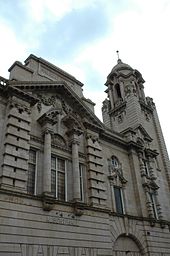 The Albert Hall, Nottingham, an important music venue.
The Albert Hall, Nottingham, an important music venue.
There is a classical music scene, with long-established groups such as the city's Symphony Orchestra, Philharmonic Orchestra, Nottingham Harmonic Society, Bach Choir, Early Music Group Musica Donum Dei and the Symphonic Wind Orchestra giving regular performances in the city.
Nottingham is also well known for Rock City, a concert venue, along with its sister venues – Rescue Rooms, The Bodega Social Club and Stealth. The city is home to a few independent record labels actively contributing for the alternative rock, pop and garage music scene, such as Hello Thor, Dead by Mono Records. The Sumac Centre based in Forest Fields has for many years supported local upcoming musicians, artists and film makers, and a variety of campaign groups. There are also a large number of live music venues promoting rock and metal music throughout the city, including The Central, The Old Angel, The Maze and Ye Olde Salutation Inn.
Wollaton Park in Nottingham hosts an annual family-friendly music event called Splendour. In 2009 it was held on Sunday 19 July and was headlined by Madness and The Pogues. Splendour returned on 24 July 2010, headlined by The Pet Shop Boys and featuring Calvin Harris, Noisettes, Athlete and OK Go among others.[38] It returned again in 2011, featuring headline acts Scissor Sisters, Blondie, Eliza Doolittle and Feeder, alongside many others.
Nottingham is renowned as one of the biggest cities supporting the Dubstep movement of dance music. Nottingham has several weekly and monthly Dubstep and Drum and Bass nights.[citation needed] It also has a strong 'DIY' music scene, with a large number of independent promoters using a variety of venues, pubs/bars, warehouse spaces and gallerys to host gigs throughout the city.
Nottingham is also one of the most well known cities outside of London for Grime music, along with Birmingham and Manchester. There are countless MC's from Nottingham, some of whome have garnered national attention, like Wariko and Fangol, who have both appeared on London radio shows. There are also a few notable grime producers, most recently the likes of the Beat Geeks. This thriving scene could be seen as a result of Nottingham's close cultural affiliation with London, and its diverse ethnic background.
Nottingham's City Ground also played host to rock band R.E.M. in 2005, the first time a concert had been staged at the football stadium.[39]
Arts and Crafts
The Hockley Arts Market, is a new arts market that runs alongside Sneinton Market on the fourth Saturday of every month. Started by a collective of Textile graduates from Nottingham Trent University, the market acts as a platform for independent artists to showcase and sell their wares. Nottingham artists are represented by The Nottingham Society of Artists, formed in 1880, to bring together artists and art lovers. They have regular exhibitions at their headquarters in St. Lukes House
Food
In the 1980s, Nottingham was barely mentioned in the Good Food Guide; but now there are several restaurant entries and a range of cuisine reflecting the ethnic diversity of the city. The Nottingham Restaurant Awards play a leading role in promoting the industry.[citation needed]
There are several hundred restaurants in Nottingham, with several AA rosette winning restaurants[40] and one Michelin starred restaurant, Sat Bains.
The Old Market Square is host to the Nottingham Food and Drink Festival.
Tourism
Nottingham receives around 300,000 overseas visitors each year.[41] Many visitors are attracted by Nottingham's nightlife and shops, by its history, and by the legend of Robin Hood, visiting Sherwood Forest and Nottingham Castle. Popular history-based tourist attractions in central Nottingham include the Castle, City of Caves, Lace Market, The Galleries of Justice, and the City's ancient pubs.
Parks and gardens include Wollaton Park (over 500 acres) near the University Highfields Park on the University of Nottingham campus, Colwick Park, which includes the racecourse, and the Nottingham Arboretum, Forest Recreation Ground and Victoria Park which are in or close to the city centre. Sherwood Forest, Rufford Country Park, Creswell Crags and Clumber Park are further away from the city itself. A new park is being developed in the city at the Eastside City development.[citation needed]
The Nottingham Robin Hood Society was originally formed by Robin Hood historian Jim Lees[42] and two Nottingham teachers Steve and Ewa Theresa West in 1972. Steve and Ewa Theresa played the part of Maid Marion and Robin Hood and attracted a ' band' of like minded followers who ' costumed up ' nearly every weekend for a function. The then society acted in street theatre, appeared at charity events and functions and for several years ' held up ' the appointed Sheriff of Nottingham at the opening of the annual Nottingham Festival. The society also made a film for Japanese Television and joined in picnics and midnight vigils around in Major Oak to promote tourism. Although a Nottingham Robin Hood Society remains, the original society members disbanded after the death of Jim Lees.
There are two main Robin Hood events throughout the Nottingham area, including the Robin Hood Pageant during October, and the Robin Hood Festival during the summer. The pageant is held at the Castle, whilst the festival is held in nearby Sherwood Forest.
In 2009 the Sheriff of Nottingham, Councillor Leon Unczur set up a Commission to look at the possibility of setting up a World Class Robin Hood Attraction. The Commission was due to report in May 2010.
In February 2008, a Ferris wheel was put up in the Old Market Square and was a major attraction of Nottingham City Council's 'Light Night' on February 8. The wheel returned to Nottingham in February 2009 to mark another night of lights, activities, illuminations and entertainment. Initially marketed as the Nottingham Eye, it was later redubbed as the Nottingham Wheel, to avoid any association with the London Eye.[43] It was seen again in 2010, and is now a much welcomed annual event happening in Nottingham.
In 2010, Nottingham has seen a rise in recommendations from publications around the world, including a positive write up in the New York Times[44] as well as being touted as one of the Top 10 Cities to Visit in 2010, alongside Delhi, Nara, Tel Aviv and Reykjavik, by DK Travel.[45]
Entertainment
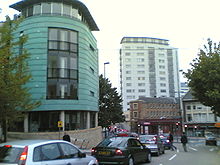 New Buildings on the South Side of the Lace Market area.
New Buildings on the South Side of the Lace Market area.
The 2,500-capacity Nottingham Royal Concert Hall and 10,000-capacity Nottingham Arena attract the biggest names in popular music. For less mainstream acts and a more intimate atmosphere, Nottingham has a selection of smaller venues, including Ye Olde Salutation Inn, Seven (formerly Junktion 7) and The Old Angel. Nottingham is host to the award-winning dedicated rock music venue Rock City and its smaller sister venues, The Rescue Rooms, The Bodega, Social Club and Stealth. These venues, with their close proximity, make Nottingham one of the centres of live popular music in the UK.
The large number of students within the city bolsters its night-time entertainment scene. There are several well established areas of the city centre focused on evening entertainment, such as Lace Market, Hockley, The Waterfront and The Corner House.
Miscellaneous
The annual Nottingham Goose Fair is held during the first week of October and is one of the largest travelling fairs in the country. The fair is held on the Forest Recreation Ground.
Nottingham won the Britain in Bloom competition, in the Large City category, in 1997, 2001, 2003 and 2007. It also won the Entente Florale Gold Award in 1998.
Nottingham is home to the acclaimed GameCity annual videogame festival, which attracts leading industry speakers from around the world.
Wikimedia UK has its registered office in Nottingham.[46]
Sport
Main article: Sport in NottinghamFootball
Nottingham is home to two high profile football clubs.
Nottingham Forest, who current play in the Football League Championship, were English league champions in 1978 and won the European Cup twice over the next two seasons under the management of Brian Clough, who was the club's manager from January 1975 to May 1993 and also led them to four Football League Cup triumphs in that time. They have played at the City Ground, on the banks of the River Trent, since 1898. Numerous high profile English and non-English international footballers have turned out for Forest over the years. Nottingham Forest joined the Football League in 1892, four years after its inception, and 100 years they were among the FA Premier League's founder members in 1992 - though they have not played top division football since May 1999.
Notts County, are the oldest of all the clubs in the world that are now professional, having been formed in 1862.[47] They were also among the Football League's founder members in 1888. For most of their history they have played their home games at Meadow Lane, which currently holds some 20,000 spectators all-seated. They currently play in Football League One - the third tier of English league football - and most recently played top division football in May 1992.
The two grounds are notable for being the closest in English league football.
Ice hockey
Ice Hockey is one of the biggest and most popular sports in Nottingham. The city is home to one of the biggest ice hockey teams in Britain, the Nottingham Panthers. The team compete in the 10 team professional Elite Ice Hockey League, and share an intense rivalry with the Sheffield Steelers.
The city is also home to the Nottingham Mavericks, a University team of players from the city's two universities.
Cricket
Nottingham is also home to the 2010 Cricket County Champions Nottinghamshire County Cricket Club, who play at Trent Bridge (a major international cricket venue with a capacity of 17,000) and a regular host of Test Cricket each summer. In 2009 the city was chosen as one of the three host cities for the ICC T20 tournament.
National Watersports Centre
The National Water Sports Centre is based at Holme Pierrepont, with a 2000 metre regatta lake for rowing, canoeing and sailing, and a white water slalom canoe course fed from the river.
Rugby Union
Nottingham is also home to Championship Nottingham RFC who play their home games at League One Notts County's Meadow Lane stadium
Other sports
Notable sporting events that take place in the city include the annual tennis AEGON Trophy which is staged at the City of Nottingham Tennis Centre and the Robin Hood Marathon.
Transport
Main article: Transport in NottinghamNottingham is served by East Midlands Airport at Castle Donington which is within 20 miles of Nottingham and is the 10th busiest airport in the UK in terms of passenger traffic. It is connected to the city by the Skylink bus service. Nottingham is also well connected by both road and rail. The M1 motorway is close by and rail services to other major cities which are all operated by East Midlands Trains with the exception of the Nottingham to Cardiff service run by CrossCountry and the Nottingham to Leeds service run by Northern Rail. The Robin Hood Line links the city with Mansfield and other towns in the north of the county.
The opening of Nottingham Express Transit in 2004 made Nottingham one of only six English cities to have a light rail system. The trams run from the city centre to Hucknall in the north, with an additional spur to the Phoenix Park Park and Ride close to Junction 26 of the M1. Two new lines are in the planning process to the southern suburbs of Wilford and Clifton and the western suburbs of Beeston and Chilwell.
 British Waterways building (formerly the Trent Navigation Company warehouse) on the Nottingham Canal
British Waterways building (formerly the Trent Navigation Company warehouse) on the Nottingham Canal
The vast majority of Nottingham’s local bus services are operated by Nottingham City Transport which runs a colour-coded network of 68 routes and is the city’s fifth largest private employer. Trent Barton is the other major bus operator, running services from Nottingham to locations throughout the East Midlands. Both companies are frequent winners at the National Bus Operator of the Year awards.
Nottingham’s waterways have been extensively used for transport in the past, with the River Trent, up until the mid 20th century, providing important industry transport links, along with both the Nottingham and Beeston Canals. These are now primarily used for leisure.
In September 2010 research by the Campaign for Better Transport rated Nottingham as the least car dependent city in England with London and Brighton & Hove in second and third place respectively.[48]
In November 2010, Nottingham City Council won Transport Authority of the Year by the UK Bus Awards, for services for providing safer and sustainable public transport.[49][50] Nottingham City Council has 2 hybrid Alexander Dennis Enviro400Hs on order which are due for delivery early next year, it is not known if they will be handed over to their owned transport operator Nottingham City Transport.
Crime
Nottingham is served by Nottinghamshire Police and has a Crown Court and Magistrates' Court.
Between 2000 and 2003 the press and other media claimed that Nottingham was the 'gun-crime capital of the UK', and was dubbed "Shottingham" in some areas.[51][52] In 2005, it had one of the highest crime rates in the country, with 115.5 crimes per 1000 people.[53] By 2007 the BBC reported that the number of shootings in the city had fallen from 51 (in 2003) to 13 (in 2006).[54] However, in January 2008 it was reported that gun crime in the city had risen for a second consecutive year, with a 50% increase in gun crime during 2007.[55] The incidence rate of many crimes in Nottingham is several times higher than the English average.[56] A crime survey by Reform stated that Nottingham topped the crime rankings for police statistics on murders, burglaries, and vehicle crime, and "had almost five times the level of crime as the safest town in the rankings". The survey was condemned as inaccurate by Nottingham City Council and Nottinghamshire Police[57] due largely to the use of out of date (2001) population figures. The University of Nottingham argued that the way in which statistics such as these are calculated is severely flawed; if the population of the entire conurbation were taken into account instead of just the centre of the city then a more accurate picture would be revealed.[58] A revised survey based on 2004 population estimates, however, appeared to back up the original rankings.[59] In 2007 TV programme Location, Location, Location named Nottingham as the 4th worst city to live in, stating the city has "loads of good aspects but crime lets it down".[60] The programme also ranked the neighbouring Nottinghamshire borough of Rushcliffe, which contains suburbs of greater Nottingham, among the best 20 places to live in the UK.[60]
While the crime figures in the city are high, initiatives introduced to tackle the levels of crime appear to be having an effect, with a 2006 Home Office survey showing that the overall level of crime in the city was down by 12% since 2003.[61] Initiatives include the Community and Neighbourhood Protection Service developed by Nottingham City Council, Nottinghamshire Police and Nottingham City Homes to take an uncompromising stance towards anti-social behaviour.[62] It comprises Community Protection Officers (CPOs), Police Officers, Police Community Support Officers (PCSOs) and Anti-Social Behaviour Officers who work with internal and external agencies to reduce anti-social behaviour and the fear of crime.
Community Protection Officers (also known as City Wardens) in their high-visibility stab vests, are accredited by the Chief Constable of Nottinghamshire Police to issue Fixed Penalty Notices (FPNs) for littering and are employed to tackle other anti-social behaviour.
Like most industrialised cities and large towns, Nottingham attracted a significant influx of Commonwealth immigrants after the Second World War. These immigrants, from Ireland, Asia and the Caribbean, were greeted with hostility from a large percentage of the city's residents, and in the summer of 1958 Nottingham was the scene of some of Britain's very first race riots.[63]
More recently, racial tension in Nottingham has been a major factor in a number of serious crimes. In July 2005, shortly after the London terrorist attacks in which 52 people were killed by Muslim suicide bombers, 48-year-old Pakistan born Muslim man Kamal Raza Butt was beaten to death in the Meadows area of the city.[64] 17-year-old white British teenager Nathan Williams was accused of his murder in May 2006 but cleared on the charge after witnesses refused to testify in court. Nathan Williams was fatally shot in the chest in the Meadows area just four months later.[65]
Religion
 The Roman Catholic Cathedral of St. Barnabas from Derby Road
The Roman Catholic Cathedral of St. Barnabas from Derby Road
Nottingham has three notable historic Anglican parish churches all of which date back to mediæval times. St. Mary the Virgin, in the Lace Market, a member of the Greater Churches Group is the oldest foundation (dating from the eighth or ninth centuries) but the building is at least the third on the site dating from 1377 to 1485. St. Mary's is considered the mother church of the city and civic services are held here, including the welcome to the new Lord Mayor of Nottingham each year. St.Peter's in the heart of the city is the oldest building in continuous use in Nottingham, with traces of building starting in 1180. St. Nicholas' was rebuilt after destruction in the Civil War.
Non-conformism was strong from the 17th century onwards[citation needed] and a variety of chapels and meeting rooms proliferated throughout the town. Many of these grand buildings have been demolished, including Halifax Place Chapel, but some have been re-used, notably High Pavement Chapel which is now a public house. The offices of the Congregational Federation are in Nottingham. William Booth, the founder of the Salvation Army, was born in Nottingham in 1829.
The Roman Catholic Cathedral of St. Barnabas on Derby Road was designed by the architect Augustus Welby Northmore Pugin, it was consecrated in 1844 and is the cathedral church for the Roman Catholic Diocese of Nottingham established in 1850 which covers Nottinghamshire (except Bassetlaw District), Leicestershire, Derbyshire (except Chesterfield and parts of the High Peak), Rutland and Lincolnshire (pre-1974 boundaries).
Today there are places of worship for all major religions, including Christianity, Islam, Hinduism, Sikhism, Taoism and Judaism. The Nottingham Inter-faith Council works to make connections between faith groups and show the wider public the importance of spiritual aspects of life and the contribution faith groups make to the community.
Media
Television
The BBC has its East Midlands headquarters in Nottingham on London Road. BBC East Midlands Today is broadcast from the city every weeknight at 6:30. Central Television the ITV region for the East Midlands until recently broadcast regional news from the city, but has now been moved to Birmingham. This decision was controversial and although a petition was set up to try to stop it, the TV studios were shut down in early 2005. Central News still keep a news bureau outside of the city at Chilwell, however. The former studios were purchased by the University of Nottingham to accommodate their administrative departments.
Radio
In addition to the national commercial and BBC radio stations the Nottingham area is served by four licenced commercial radio stations (though all broadcast to a wider area than the city), three community radio stations, one student station broadcasting on a Low powered AM Restricted Service Licence and a BBC local radio station.
BBC Radio Nottingham
Broadcast from the BBC East Midlands studios on London road across the county is BBC Radio Nottingham which was once home to (BBC Radio Five Live's Simon Mayo who was the rival to Trent's Dale Winton.
Gold
Gold is a quasi national MW station playing classic hits across the UK. The station started life in the East Midlands as GEM AM on 4 October 1988 as a split service from Radio Trent and Leicester Sound and was initially broadcast to Nottingham, Derby, and Leicester – however broadcasts on MW ceased in Leicester in 1995. The station was rebranded Classic Gold GEM in the mid 1990s and by 2007 most local programming had already ceased, at which point it became part of the new national Gold service will all local programming (except news and advertising) ending.
Gem 106
Gem 106 (formerly Radio 106, Century FM and Heart 106) is a regional Adult Contemporary radio station which has broadcast to the whole East Midlands from its headquarters in the City Link business park (the same location as the BBC) since its launch in 1997.
Smooth
Smooth Radio was launched (as Saga 106.6 fm) in 2004 as a new service for the East Midlands serving the over 50s from its base in Nottingham. In 2008 the station was relaunched as 106.6 Smooth Radio playing classic hits and modern easy listening music to an older audience. In October 2010 the station became part of the national Smooth Radio and all local programming ended – only local news and advertising remains.
Capital FM
Capital FM (was Trent FM, originally Radio Trent) was Nottinghamshire's first commercial radio station and currently broadcasts across the East Midlands from its studios in Nottingham. Prior to 2008, the Trent FM building was a converted Victorian hospital which connects to the underground network of caves. Many famous presenters have been employed at Trent FM (formerly Radio Trent), including Dale Winton, Kid Jensen, John Peters and Penny Smith.
The station was rebranded and merged with neighbouring stations Leicester Sound and Ram FM on Monday 3 January 2011, airing regional breakfast and drivetime programming alongside networked output from London.
Student Radio
Student Radio is broadcast in the city permanently by URN (University Radio Nottingham). URN has won many awards for quality and which is broadcast on medium wave (AM) around the main campus (University Park) at 1350 kHz and from Sutton Bonnigton campus on 1602 kHz. It is also streamed over the Internet.[66] Nottingham Trent University also runs the equally successful FlyFM, based at the university's city campus, broadcasting online at www.flyfm.co.uk. New College Nottingham also broadcast an online radio station, NCN RADIO which has received wide notability for its shows.[says who?]
There are also three community radio stations serving the city; Faza FM on 97.1FM is aimed at Asian women and their families. Faza has been broadcasting since 2002; Dawn FM on 107.6FM used to share its broadcast hours with Faza, but in 2006 became a separate service in its own right – broadcasting news, current affairs and music of relevance to the Asian (specifically Islamic) community within the city; Kemet Radio on 97.5 broadcasts urban music while also serving the Afro-Caribbean community. Prior to its launch in 2007 such programming had only been available on pirate radio stations Unique 106.3 (later 107.3) and 107.9 Switch FM (later Freeze FM, networked with the London pirate of the same name), both of which appear to have ceased broadcasts as of late 2006.
Newspapers and magazines
Nottingham's main local newspaper, the Nottingham Post, is owned by Northcliffe Media and is published daily from Monday to Saturday each week. There are also a number of other publications which focus on individual areas within the city, for instance the Hucknall and Bulwell Dispatch.
A local culture and listings magazine is available free from many sites around the city called LeftLion, whilst a complimentary, bi-monthly glossy magazine is also available from a number of outlets across the city called Life&Style Magazine. This consists of features typically focused on the area's interest in fashion, entertainment and politics.
Nottingham Trent University's Student Union produces the regular Platform Magazine, while Impact Magazine is a monthly magazine written for, and written by students at the University of Nottingham. It has won many national awards for student journalism, and is entirely run by, compiled, and edited by students at the University.
The quarterly Ceasefire Magazine is also based in Nottingham.
Alternative media
Community news project Nottinghamshire Indymedia, which was set up in April 2005, works within a variety of groups to create community media and collaboration between communities throughout the county. At the centre of the project is an online news site, which is run on the principles of open publishing.
Online entertainment guide NG Magazine covers music, events and entertainment in the city, while This City exclusively covers local music.
The Registered Office of Wiki UK Limited who use the operating name of Wikimedia UK is in Nottingham.[67]
Film
Nottingham has been used as a location in many locally, nationally, and internationally, produced films. Movies that have been filmed (partly or entirely) in Nottingham include:[68]
- Saturday Night and Sunday Morning (1960)
- The Loneliness of the Long Distance Runner (1962)
- The Ragman's Daughter (1972)
- In Celebration (1975)
- Twenty Four Seven (1997)
- Once Upon a Time in the Midlands (2002)
- One for the Road (2003)
- Nottingham Nobody (2004)
- This Is England (2006)
- Magicians (2007)
- Control (2007)
- Mum & Dad (2008)
- Bronson (2009)
- The Unloved (2009)
- Le Donk & Scor-zay-zee (2009)
- Goal 3 (2009)
- Bunny and the Bull (2009)
- A Boy Called Dad (2009)
- Big Things (2009)
- We Need to Talk About Kieran (2010)
- Oranges and Sunshine (2010)
- The Dark Knight Rises (2011)
- Weekend (2011)
Nottingham is home to Wellington Films, an independent production company most notable for their award-winning film London to Brighton.
Twin cities
Nottingham is twinned with the following cities:[69]
Country Place County / District / Region / State Date 
Slovenia 
Ljubljana 
City Municipality of Ljubljana 1963 
Belarus 
Minsk 
Minsk Voblast 1966 
Germany 
Karlsruhe 
Baden-Württemberg 1969 
Zimbabwe 
Harare Harare Province 1981 
Belgium 
Ghent 
Flemish Region 1985 
China Ningbo Zhejiang Province 2005 
Romania 
Timişoara 
Timiş County 2008 Notable people
Main article: List of people from NottinghamSee also: Category:People from NottinghamList of Mayors and Lord Mayors
Main article: Lord Mayor of NottinghamThe Sheriff of Nottingham
Main article: Sheriff of NottinghamMain article: Sheriff of Nottingham (position)See also
- Snotingas
References
- ^ "A brief A-Z of Nottingham". Atschool.eduweb.co.uk. http://atschool.eduweb.co.uk/southwold/project/local/AZnottingham.htm. Retrieved 2010-07-13.
- ^ "Population of Nottingham". Mongabay.com. http://population.mongabay.com/population/united-kingdom/2641170/nottingham. Retrieved 18 June 2010.
- ^ Neighbourhood Statistics. "Lead View Table". Neighbourhood.statistics.gov.uk. http://www.neighbourhood.statistics.gov.uk/dissemination/LeadTableView.do?a=3&b=276829&c=nottingham&d=13&e=13&g=395722&i=1001x1003x1004&m=0&r=1&s=1206563790122&enc=1&dsFamilyId=1812. Retrieved 2010-07-13.
- ^ http://www.nottinghamcity.gov.uk/index.aspx?articleid=2399
- ^ Graham Pointer (2005). "The UK's major urban areas" (PDF). http://www.statistics.gov.uk/downloads/theme_compendia/fom2005/03_FOPM_UrbanAreas.pdf. Retrieved 2007-03-22.
- ^ "Adobe PDF – Travelling by Train Guide – Welsh" (PDF). http://fsd.lincolnshire.gov.uk/upload/public/attachments/1105/TBTWelsh.pdf. Retrieved 2010-07-13.
- ^ A P Nicholson (9 May 2003). "Meaning and Origin of the Words. Shire and County". http://www.nottshistory.org.uk/swinnerton1910/chapter1.htm. Retrieved 2007-03-22.
- ^ Thomas Chambers Hine (1876) Nottingham Castle; Nottingham, Eng. Museum and Art Gallery. London:Hamilton, Adams & co.
- ^ Medieval English Alabaster Carvings in the Castle Museum Nottingham, Francis Cheetham, City of Nottingham art Galleries and Museums Committee, 1973
- ^ A Centenary history of Nottingham. J. V. Beckett
- ^ "Relationships / unit history of Nottingham". A Vision of Britain Through Time. http://www.visionofbritain.org.uk/relationships.jsp?u_id=10001389&c_id=10001043. Retrieved 2007-03-22.
- ^ "localhistories.org". localhistories.org. http://www.localhistories.org/nottingham.html. Retrieved 2010-07-13.
- ^ [1]
- ^ [2]
- ^ [3]
- ^ [4]
- ^ ">August 1990". http://eca.knmi.nl/utils/monitordetail.php?seasonid=0&year=1990&indexid=TXx&stationid=2118. Retrieved 2011-02-25.
- ^ ">August 1990". http://www.metoffice.gov.uk/climate/uk/interesting/aug1990/. Retrieved 2011-02-25.
- ^ "> >25c Days". http://eca.knmi.nl/utils/calcdetail.php?seasonid=0&periodid=1971-2000&indexid=SU&stationid=2118. Retrieved 2011-02-25.
- ^ "> >Annual Average Maximum". http://eca.knmi.nl/utils/calcdetail.php?seasonid=0&periodid=1971-2000&indexid=TXx&stationid=1850. Retrieved 2011-02-25.
- ^ "> >Watnall Frost average". http://eca.knmi.nl/utils/calcdetail.php?seasonid=0&periodid=1971-2000&indexid=FD&stationid=2118. Retrieved 2011-02-25.
- ^ "> >Sutton Bonington Frost average". http://www.metoffice.gov.uk/climate/uk/averages/19712000/sites/sutton_bonnington.html. Retrieved 2011-02-25.
- ^ "> 1963 minimum". http://eca.knmi.nl/utils/monitordetail.php?seasonid=0&year=1963&indexid=TNn&stationid=2118. Retrieved 2011-02-25.
- ^ "> 1987 minimum". http://eca.knmi.nl/utils/monitordetail.php?seasonid=0&year=1987&indexid=TNn&stationid=2118. Retrieved 2011-02-25.
- ^ "> 2010 minimum". http://eca.knmi.nl/utils/monitordetail.php?seasonid=18&year=2010&indexid=TNn&stationid=2118. Retrieved 2011-02-25.
- ^ "Climate Normals 1971–2000". YR.NO. June 2011. http://www.yr.no/place/United_Kingdom/England/Mansfield/statistics.html. Retrieved 25 feb 2011.
- ^ "Climate Normals 1971–2000". KNMI. http://eca.knmi.nl/utils/mapserver/climatology.php?indexcat=**&indexid=**&periodidselect=1971-2000&seasonid=0&scalelogidselect=no&minx=-461428.571429&miny=-4727380.952381&maxx=405238.095239&maxy=-4077380.952380&MapSize=560%2C420&imagewidth=560&imageheight=420&CMD=QUERY_POINT&CMD=QUERY_POINT#bottom. Retrieved 25 feb 2011.
- ^ "Climate Normals 1971–2000". MetOffice. June 2011. http://www.metoffice.gov.uk/climate/uk/averages/19712000/sites/sutton_bonnington.html. Retrieved 25 feb 2011.
- ^ "How different areas performed". BBC News. 5 December 2006. http://news.bbc.co.uk/1/hi/education/7130024.stm. Retrieved 2007-03-22.
- ^ "How different areas performed". BBC News. 19 January 2006. http://news.bbc.co.uk/1/hi/education/7180228.stm. Retrieved 2007-03-22.
- ^ "Science-city.co.uk". Science-city.co.uk. 2010-04-29. http://www.science-city.co.uk/. Retrieved 2010-07-13.
- ^ "Visionnottingham.com". Visionnottingham.com. http://www.visionnottingham.com/sector.asp?pageid=81. Retrieved 2010-07-13.
- ^ "Visionnottingham.com". Visionnottingham.com. http://www.visionnottingham.com/. Retrieved 2010-07-13.
- ^ "Sub-regional: Gross value added1 (GVA) at current basic prices". Office for National Statistics. http://www.statistics.gov.uk/downloads/theme_compendia/regional_snapshot_2006/SubregionalGVA.xls. Retrieved 2007-05-05.
- ^ "Retail Footprint 2010 reveals Britain's shopping successes and strugglers". CACI. 21 May 2010. http://www.caci.co.uk/492.aspx. Retrieved 18 August 2010.
- ^ http://www.broadway.org.uk/
- ^ http://nottingham.savoycinemas.co.uk/
- ^ "Splendour 2010 – Pet Shop Boys – Wollaton Park 24th July 2010". Splendourfestival.co.uk. http://www.splendourfestival.co.uk/. Retrieved 2010-07-13.
- ^ http://www.bbc.co.uk/nottingham/content/articles/2005/07/07/entertainment_music_gig_reviews_2005_07_rem_city_ground_feature.shtml
- ^ "restaurant guide". Go dine. http://www.godine.co.uk/Nottingham-Restaurants.aspx. Retrieved 2010-07-13.
- ^ "Overseas Visitors to the UK – Top Towns Visited 2005" (PDF). VisitBritain. Archived from the original on 2008-06-25. http://web.archive.org/web/20080625033649/http://www.tourismtrade.org.uk/Images/TopTowns2005_tcm12-24666.pdf. Retrieved 2007-01-28.
- ^ "obinhood.info". Robinhood.info. 2001-11-18. http://www.robinhood.info/robinhood/Jim_Lees_Obituary.html. Retrieved 2010-07-13.
- ^ "BBC News". BBC News. 2009-03-03. http://news.bbc.co.uk/1/hi/england/nottinghamshire/7920362.stm. Retrieved 2010-07-13.
- ^ Miller, Josey (2010-02-21). "Nottingham's Soulful Side?". The New York Times. http://travel.nytimes.com/2010/02/21/travel/21surfacing.html?ref=travel. Retrieved 2010-04-10.
- ^ "The Top 10 cities to visit in 2010". The Times (London). 2009-11-25. http://www.timesonline.co.uk/tol/travel/holiday_type/breaks/article6930112.ece?token=null&offset=12&page=2. Retrieved 2010-04-10.
- ^ "Welcome to Wikimedia UK." Wikimedia UK. Retrieved on 8 May 2010. "The Registered Office is at 23 Cartwright Way, Nottingham, NG9 1RL, United Kingdom."
- ^ Notts County - A Pictorial History by Paul Wain, page 8, ISBN 0954783034
- ^ "Car Dependency Scorecard". Campaign for Better Transport. 20 September 2010. http://www.bettertransport.org.uk/campaigns/traffic_reduction/scorecard#not. Retrieved 23 September 2010.
- ^ "City Council is Bus Authority of the Year". Nottingham City Council. 17 November 2010. http://www.nottinghamcity.gov.uk/index.aspx?articleid=12504. Retrieved 18 November 2010.
- ^ "Transport Authority of the Year 2010". ukbusawards.org.uk. November 2010. http://www.ukbusawards.org.uk/content/index.php?option=com_content&view=article&id=441&Itemid=194. Retrieved 18 November 2010.
- ^ Doward, Jamie (2007) "Brutal ganglord who fell victim to his own drugs", The Observer, 5 August 2007. Retrieved 16 January 2010.
- ^ Alderson, Andrew & Copping, Jasper (2007) "Police joined dark side to regain Nottingham", Daily Telegraph, 5 August 2007. Retrieved 16 January 2010.
- ^ Games, Alex (2007). Balderdash & piffle : one sandwich short of a dog's dinner. London?: BBC. ISBN 9781846072352.
- ^ "Slight rise in shootings in city". BBC. 2007-03-20. http://news.bbc.co.uk/1/hi/england/nottinghamshire/6472687.stm. Retrieved 2007-03-31.
- ^ "City sees new rise in shootings". BBC. January 2008. http://news.bbc.co.uk/1/hi/england/nottinghamshire/7170441.stm. Retrieved 4 January 2008.
- ^ "Crime figures for 2005/2006". UpMyStreet. http://www.upmystreet.com/local/police-crime/l/Nottingham.html. Retrieved 2007-03-31.
- ^ "Rebuttal of reform's urban crimes ranking report". Nottingham City Council. Archived from the original on 2007-09-27. http://web.archive.org/web/20070927222736/http://www.nottinghamcity.gov.uk/sitemap/policing_and_public_safety/wt_rebuttal_of_reform_s_urban_crimes_ranking_report.htm. Retrieved 2007-03-22.
- ^ "Nottingham Life – NOT Capital for Crime". The University of Nottingham. May 2006. Archived from the original on 2008-03-17. http://web.archive.org/web/20080317130307/http://www.nottingham.ac.uk/nottingham-life/truecrime.php. Retrieved 2008-01-12.
- ^ Blair Gibbs & Andrew Haldenby (July 2006). "Urban crime rankings" (PDF). Reform. Archived from the original on 2008-03-08. http://web.archive.org/web/20080308195432/http://www.reform.co.uk/filestore/pdf/Urban+crime+rankings,+Reform,+July+2006.pdf. Retrieved 2007-03-31.
- ^ a b "Nottingham: 4th Worst Place To Live 2007". Channel 4. June 2010. http://www.channel4.com/4homes/on-tv/best-and-worst/nottingham-4th-worst-place-to-live-in-the-uk-08-06-05_p_1.html.[dead link]
- ^ "Some facts about crime in Nottinghamshire". Nottingham City Council. July 2006. Archived from the original on 2008-05-03. http://web.archive.org/web/20080503090412/http://www.nottinghamcity.gov.uk/sitemap/policing_and_public_safety/wt_facts_crime_nottm.htm. Retrieved 2007-03-31.
- ^ "Community and Neighbourhood Protection Service". Nottingham City Council. Archived from the original on 2008-03-18. http://web.archive.org/web/20080318230600/http://www.nottinghamcity.gov.uk/sitemap/services/policing_and_public_safety/ns_neighbourhood_wardens.htm. Retrieved 2007-03-31.
- ^ "Riots and lynchings, fascists and immigrants: what’s changed?". Searchlight Magazine. http://www.searchlightmagazine.com/index.php?link=template&story=35. Retrieved 2010-07-13.
- ^ "Forty-seven race murders in Britain since Macpherson". IRR. http://www.irr.org.uk/2005/august/ak000005.html. Retrieved 2010-07-13.
- ^ Askill, John (2006-09-28). "Shot lad, 17, 'was killer' | The Sun |News". The Sun. http://www.thesun.co.uk/sol/homepage/news/article65022.ece. Retrieved 2010-07-13.
- ^ "Urn1350.net". Urn1350.net. http://www.urn1350.net/. Retrieved 2010-07-13.
- ^ Wikimedia UK
- ^ "Most Popular Titles With Filming Locations Matching "Nottingham"". IMDb. http://www.imdb.com/search/text?realm=title&field=locations&q=Nottingham. Retrieved 2010-03-23.
- ^ "Nottinghamcity.gov.uk". Nottinghamcity.gov.uk. 2010-04-28. http://www.nottinghamcity.gov.uk/index.aspx?articleid=2636. Retrieved 2010-07-13.
External links
- Nottingham City Council website
- BBC Nottingham website
- Nottingham travel guide from Wikitravel
- Arts and craft in and around Nottingham
- Visit Nottingham
Nottingham About Nottingham Areas of Nottingham Arboretum · Aspley · Bakersfield · Bilborough · Bulwell · Basford · Carrington · Clifton · Dunkirk · Forest Fields · Hockley · Hyson Green · Lace Market · Lenton · Lenton Abbey · Mapperley · The Meadows · The Park · Radford · Sherwood · Sneinton · St Ann's · Strelley · Top Valley · Wilford · WollatonCeremonial county of Nottinghamshire Unitary authorities Boroughs or districts Major settlements Arnold · Beeston · Bingham · Bircotes · Blidworth · Carlton · Cotgrave · Eastwood · Harworth · Hucknall · Kimberley · Kirkby-in-Ashfield · Mansfield · Mansfield Woodhouse · Netherfield · Newark · Nottingham · Ollerton · Rainworth · Retford · Ruddington · Stapleford · Southwell · Sutton-in-Ashfield · West Bridgford · Worksop
See also: List of civil parishes in NottinghamshireTopics Derbyshire Amber Valley • Bolsover • Chesterfield • Derby • Derbyshire Dales • Erewash • High Peak • North East Derbyshire • South Derbyshire

Leicestershire Lincolnshire Nottinghamshire Ashfield • Bassetlaw • Broxtowe • Gedling • Mansfield • Newark and Sherwood • Nottingham • Rushcliffe
Northamptonshire Rutland Cities of the United Kingdom England Bath · Birmingham · Bradford · Brighton and Hove · Bristol · Cambridge · Canterbury · Carlisle · Chester · Chichester · Coventry · Derby · Durham · Ely · Exeter · Gloucester · Hereford · Kingston upon Hull · Lancaster · Leeds · Leicester · Lichfield · Lincoln · Liverpool · London · Manchester · Newcastle upon Tyne · Norwich · Nottingham · Oxford · Peterborough · Plymouth · Portsmouth · Preston · Ripon · St Albans · Salford · Salisbury · Sheffield · Southampton · Stoke-on-Trent · Sunderland · Truro · Wakefield · Wells · Westminster · Winchester · Wolverhampton · Worcester · York
Scotland Wales Northern Ireland 25 largest settlements in the UK by urban core population* - London: 7,172,091
- Birmingham: 970,892
- Glasgow: 629,501
- Liverpool: 469,017
- Leeds: 443,247
- Sheffield: 439,866
- Edinburgh: 430,082
- Bristol: 420,556
- Manchester: 394,269
- Leicester: 330,574
- Coventry: 303,475
- Kingston-upon-Hull: 301,416
- Bradford: 293,717
- Cardiff: 292,150
- Belfast: 276,459
- Stoke-on-Trent: 259,252
- Wolverhampton: 251,462
- Nottingham: 249,584
- Plymouth: 243,795
- Southampton: 234,224
- Reading: 232,662
- Derby: 229,407
- Dudley: 194,619
- Newcastle upon Tyne: 189,863
- Northampton: 189,474
*Based on 2001 Census data. Robin Hood Characters Robin Hood · Maid Marian · Merry Men · Much the Miller's Son · Little John · Friar Tuck · Alan-a-Dale · Will Scarlet · Will Stutely · Gilbert Whitehand · Arthur a Bland · David of Doncaster · Sheriff of Nottingham · Sir Guy of Gisbourne · Prince John · Bishop of Hereford · Richard at the LeeSettings Adaptations Categories:- Nottingham
- Cities in the East Midlands
- County towns in England
- Local government in Nottinghamshire
- Nottinghamshire
- Robin Hood locations
- Unitary authorities of England
- University towns in the United Kingdom
- Local government districts of the East Midlands
Wikimedia Foundation. 2010.


